Overview of Lenten Rose
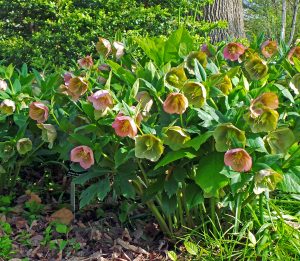
Helleborus × hybridus is a group of evergreen, late-winter or early-spring flowering perennials in the buttercup family (Ranunculaceae) with common names including hellebore, oriental hellebore, and Lenten rose (the name Christmas rose refers to H. niger). Helleborus (hellebore) is a small genus of about 20 species of herbaceous perennials native to Europe and Asia. The species are rarely used in gardens as hellebores hybridize easily and many improved varieties with superior flowering and flower colors have been developed. Formerly known as Helleborus orientalis hybridus — a confusing and incorrect name since H. orientalis is a distinct species — garden hybrids are collectively called H. × hybridus (although often they are offered in the trade as H. orientalis). These Lenten roses are hybrids of at least nine species but there are additional interspecific hybrids, such as H. × ballardiae (H. niger crossed with H. lividus), that are offered as ornamental plants for the garden. Lenten rose is hardy from Zone 5 to 9, and colder when plants have with winter protection such as mulch or good snow cover.
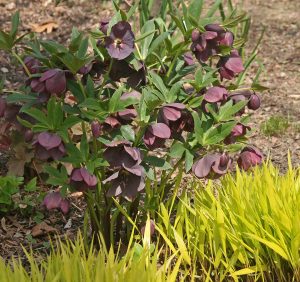
Mature plants can form clumps that are 18” to 24” tall and 24” to 30” wide. The glossy, deep green foliage can be quite variable in color and shape, even within the same hybrid. Leaves are divided into 7 to 9 segments with an umbrella-like shape. Lenten roses have tough, almost woody stems with leaves and terminal inflorescence on the same stem. The toothed, leathery foliage remains attractive throughout the growing season, remaining evergreen in mild climates and even persisting under snow (but decline over the winter, often flattened on the ground).

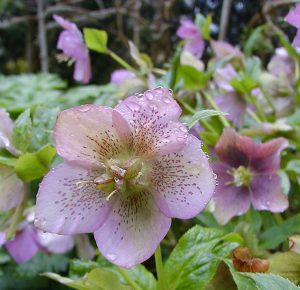
Flower buds form during the previous summer, with the distinctive, 1-2” wide, long-lasting flowers blooming in early spring along with daffodils and tulips. Flower spikes emerge from the underground rhizome in late winter. Five petal-like sepals (a modified calyx) surround a ring of small, yellowish-green, tubular, nectaries in an open, bell shape. The nectaries are actually the petals modified to hold nectar. Inside the ring of petals there are numerous stamens and several pistils. After the flower is pollinated, the petals and stamens fall off but the sepals do not drop, remaining on the plant for 1-2 months or more (probably contributing to seed development). Mature plants often have 50 or more flowers per plant. Blooms make good cut flowers, and their seed heads add interest in dried arrangements.

Flowers of hellebore garden hybrids come in a rainbow of colors in both single or double forms. Flower color ranges from pure white to a plum color bordering on black, with clear red, pink, yellow, green or cream; others can be speckled, spotted and mottled on the inside of the flower; and some havepicotee edges (narrow margins of a darker color). The outside of the sepals is often green-tinged, and most flowers become greener as they age.

Flowers are often followed by unusual seed pods that offer ornamental interest and can produce viable seeds if left on the plant. The carpels eventually dry and split to release bean-shaped, shiny black seeds, each with a white appendage (elaiosome), that become wrinkled with age.

Landscape Use
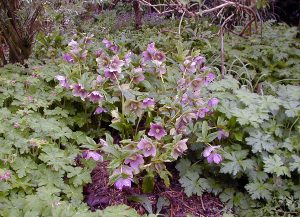
Lenten roses are an outstanding combination plant for adding color, texture, and form to ornamental shade gardens, areas between deciduous shrubs and under trees, or in naturalized woodland areas. They can be stars in an early spring garden as specimen plants, in masses as a foil for other spring bulbs and can even be used as a tall ground cover. Lenten rose combines well with other spring-blooming perennials such as barrenwort (Epimedium spp.), wood anemone (Anemone nemorosa) and Hepatica. Later in the season the foliage provides a nice backdrop for hostas and other shade perennials. They are also excellent for planting on a hillside above a path where the downward-facing flowers can be viewed from below.
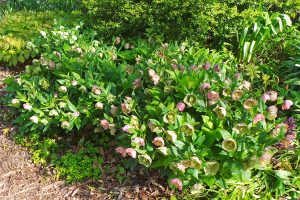
General Care of Lenten Rose
Lenten rose does best in partial to full sun and well-drained, fertile garden soil with high levels of organic matter. In the Midwest they will grow well in sun, but in more southern locations require some shade. Lenten rose is relatively drought tolerant once established but do best with consistent moisture. The plants are very sensitive to soggy soil, so the site must have good drainage. Lenten rose requires little maintenance. The previous season’s leaves will be dried and tattered after the winter and are best cut off at the ground as the flowers emerge in the spring. Fertilize in early spring, and mulch in winter (with evergreen boughs or marsh hay) in colder areas. Like other members of the Ranunculaceae, hellebores have alkaloids in the leaves and seeds that can cause mild dermatitis in sensitive individuals, so gardeners should wear gloves when exposure might occur. These same alkaloids make the leaves undesirable to deer and rabbits, but slugs may eat their flowers.
Propagation of Lenten Rose
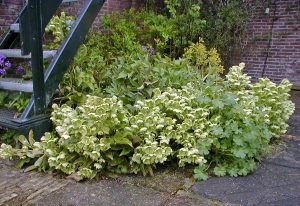
Commercial plants are propagated from seed, division or tissue culture. Germination is slow and it can take four or five years to produce a plant of flowering size, and seedlings will not come true from seed. Seeds ripen in late spring and early summer and must be sown fresh. Leaving seed pods on the plants to allow volunteers to sprout is probably the easiest way to get seedlings. These can be carefully dug to move to pots or other areas of the garden or left to enlarge the clump. Established clumps can be left alone for 20 or more years but may be divided (each division should have several crowns), preferably in the fall or at flowering time. The recovery time is slow with division.
Varieties of Lenten Rose
- HONEYMOON® series is a seed propagated, vigorous, single flowered strain with flowers ranging from apricot orange, dark purple, mauve, pin, white, wine red and yellow. Bred by Hans Hansen.
- IVORY PRINCE® (variety ‘Valhelivor’, plant patent 16,199) is a vigorous vegetative cultivar with dark green leaves with slivery highlights. Burgundy pink buds open to produce outward facing, ivory white flowers.
- WEDDING PARTY® series from Hans Hansen is a vigorous, double flowered strain available in a range of colors, including dark purple, mauve, pink, white and yellow.
- WINTER JEWELS® series includes both single and double flowered forms in a range of colors. Bred by Marietta O’Byrne of Northwest Garden Nursery in Portland, Oregon.
– Susan Mahr, University of Wisconsin – Madison
Last Update: Bruce Spangenberg, UW-Madison Extension, 2025





 Aster, Symphyotrichum spp.
Aster, Symphyotrichum spp. Fascinating Fasciation
Fascinating Fasciation Alternatives to Lawn: Groundcovers
Alternatives to Lawn: Groundcovers Marigolds
Marigolds


